Developments in the projector world – especially for home theatre use – tend to move at a glacial rate compared with TVs, but Epson’s current flagship EH-LS10000 may well be one of the most revolutionary projectors we’ve seen in recent years alongside Sony’s groundbreaking native 4K models.
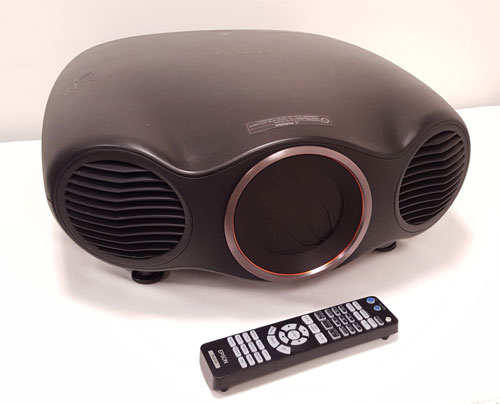
The LS10000’s star feature is undoubtedly its laser light engine which obviates the need for projector bulb change and re-calibration. There were other benefits too: start-up was amazingly quick – it took only around 20 seconds from a keypress of the power button to a watchable image appearing on screen, while shutdown was near-instantaneous. The unit also ran quieter than all other lamp-based projectors we’ve reviewed, with the least demanding [ECO] mode being essentially silent in our test environment.
Even the design is decidedly futuristic despite the projector’s relatively large footprint, with its sleek curvaceous lines resembling a spaceship, and the connection ports well-hidden underneath a detachable rear cover to keep things streamlined. Two HDMI inputs that can accept 4K@60p/ 50p video signals albeit only at 8-bit 4:2:0 chroma (i.e. HDMI 2.0 level b) are provided, of which HDMI1 is compliant with HDCP 2.2 copy protection standard. Lens shift, zoom and focus are all done electronically via the remote control (up to five lens memory setups can be saved), which together with the motorised lens cover adds to the laser projector’s next-gen aura.
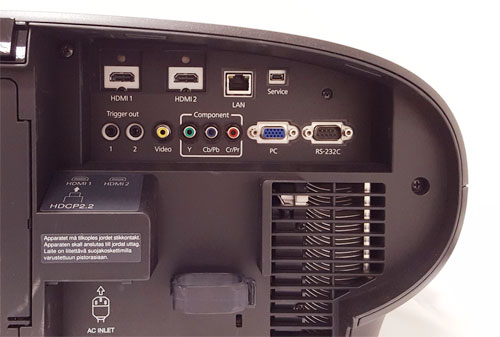
The Epson EHLS10000’s list of attractions doesn’t end here. Onboard 3-chip Liquid Crystal on Quartz (LCoQ) technology – a variant of LCoS (Liquid Crystal on Silicon) – promises deeper blacks, and in our testing we found the LS10000’s black level to fall somewhere between JVC’s class-leading D-ILA projectors and Sony’s SXRD models. However, at the other end of the contrast ratio spectrum, the Epson can go brighter than the JVCs, making it a more suitable choice for non-light-controlled rooms, or very large projection screens.
Calibration was straightforward with a profiled Klein K10-A meter, DVDO’s AVLab TPG signal generator and SpectraCal’s CalMAN Ultimate software. The British version doesn’t come with a [THX] picture preset that’s available on its US counterpart, but as was the case with most Epson projectors, “Natural” [Color Mode] was perfectly serviceable as a platform for further image tuning. Using the supplied [RGB] 2-point white balance controls and [RGBCMY] colour management system, we had no difficulty achieving accurate greyscale and colours on our EH-LS10000 review sample. Post-calibration lumens measurement came in at 796 with [Power Consumption] set to “Medium” on our setup.
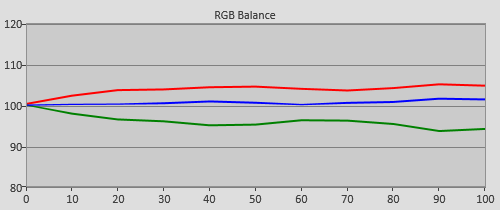 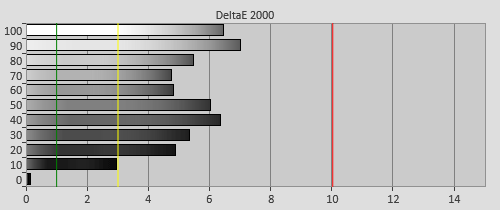 |
| Pre-calibration RGB tracking and delta errors (dEs) |
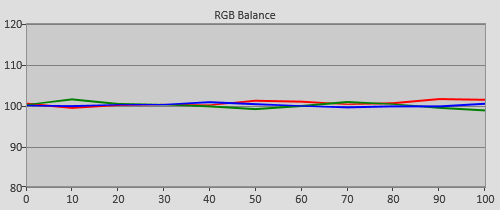 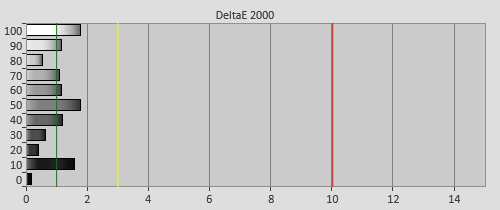 |
| Calibrated RGB tracking and dEs in “Natural” [Color Mode] |
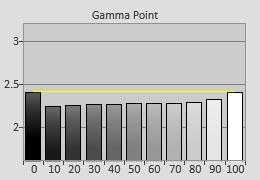 | 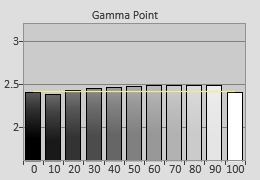 |
| Pre-calibration gamma tracking (2.27) | Post-calibration gamma tracking (2.46) |
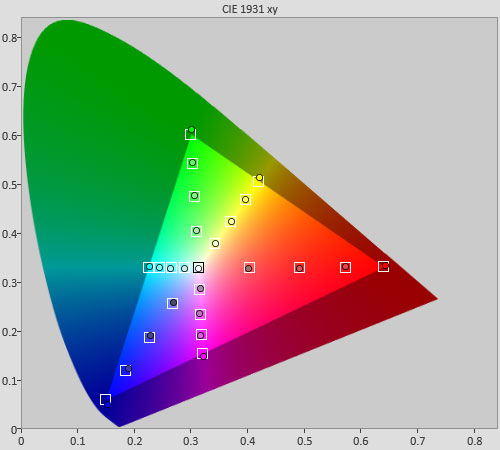 |
| Post-calibration colour saturation tracking |
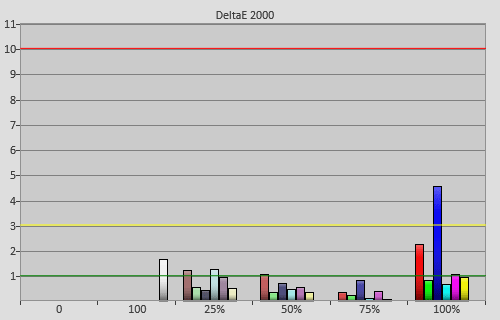 |
| Post-calibration colour errors (<3 not appreciable to the eye) |
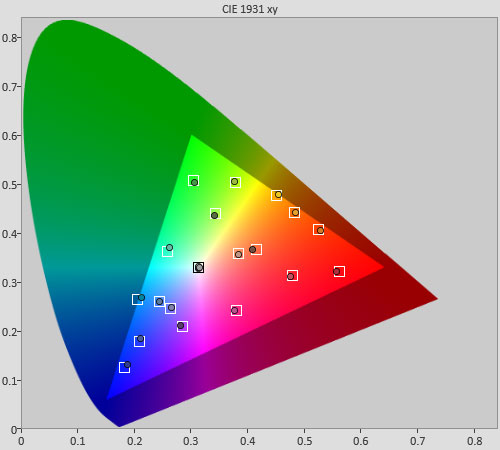 |
| Post-calibration Colour Checker Classic test |
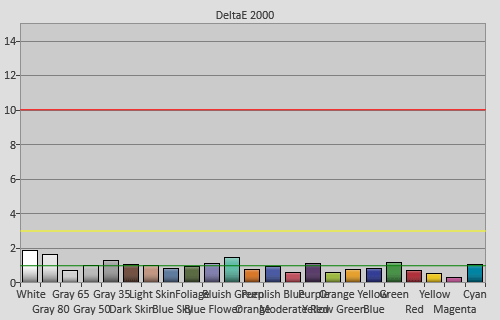 |
| Post-calibration Colour Checker Classic errors (<3 not visible to the eye) |
Embedded within the user menu of Epson projectors is a [Skin Tone] slider, which merely shifted the white balance warmer or cooler, and cannot be used in the same way as the [Flesh Tone] control implemented on Samsung TVs to adjust skin colour hues in a laser-targeted fashion. In any case, flesh tones and general colours looked wonderfully realistic after greyscale and colour calibration without touching the [Skin Tone] control.
| Dead pixels | None |
| Panel uniformity | Very good |
| Primary chromaticity | Very good |
| Motion resolution (approx.) | 600 with [Frame Interpolation] on; 300 otherwise |
| Digital noise reduction | Defeatable |
| Sharpness | Defeatable |
| Luma/Chroma bandwidth (Blu-ray) | Full Luma, Chroma horizontally blurred |
| 1080p/24 capability | No judder in 2D; mild judder in 3D |
| Measured DCI-P3 coverage | 98% |
| Input lag (Leo Bodnar tester) | 57ms with [Image Processing] “Fast“ |
| Full 4:4:4 reproduction (PC) | No |
The Epson LS10000 is equipped with a “4K Enhancement” feature which works not dissimilarly to JVC’s e-Shift technology, attempting to deliver higher-than-1080p resolution through diagonal pixel offsetting from 1920×1080 panels. Although the EHLS10000 had no problem displaying UHD (ultra high-definition) signals at 50Hz and 60Hz from a DVDO AVLab test pattern generator, the projector failed to resolve either the 3840 vertical or the 2160 horizontal alternating black-and-white single-pixel lines (which merged into a solid grey screen). This is hardly surprising given that the underlying imagers are 1080p, and is in line with the results we’ve obtained from the JVC’s eShift projectors.
Of course, resolution is only one single component of the Ultra HD equation. The EH-LS10000 doesn’t do HDR (high dynamic range), but thanks to its laser light source, the projector covered an amazing 98% of the DCI-P3 colour gamut standard – the highest we’ve ever measured on any consumer display (including televisions) to date:
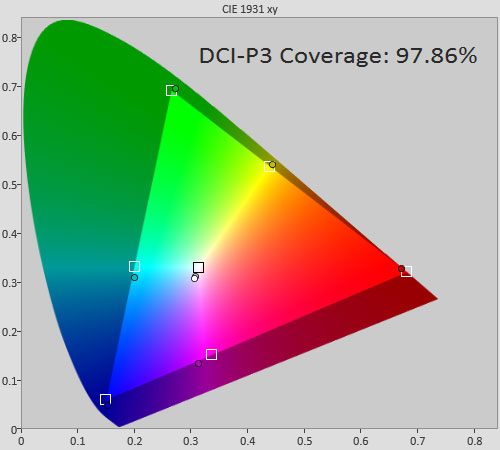
The 4K enhancement tech can be applied to 1080p sources in five intensities by setting [Super-resolution/4K] from the lowest strength of “4K-1” to the most aggressive “4K-5“. In practice, we found “4K-1” to blur the HD image ever so slightly, reducing the screen door effect but unfortunately also smudging fine detail. Going higher up the [Super-resolution/4K] ladder would just introduce more edge enhancement and unnaturalness to the picture; in the end we simply switched it off to let all the detail from pristine Blu-rays reach the screen unscathed without unnecessary processing.
Click on the options below to compare [Super-resolution/4K] modes:
“4K-1” | “Off”
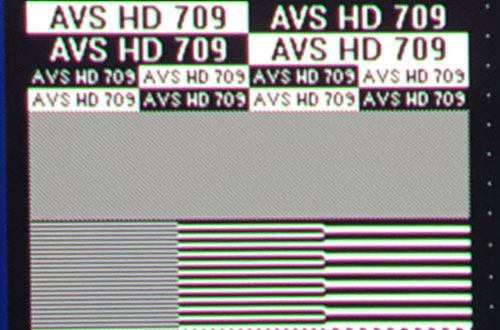
Engaging [Frame Interpolation] doubled motion resolution (as determined via the horizontally scrolling lines in Chapter 31 of the FPD Benchmark Software test disc) to 600 from the LCD baseline of 300. The “Normal” and “High” settings resulted in unmistakable soap opera effect (SOE) and more frequent interpolation artefacts, so we’d stick to “Off” or “Low” for watching movies. The Epson EH-LS10000 handled 1080p/24 content in 2D mode without judder even with [Frame Interpolation] disabled.
Epson ships the EHLS10000 with two pairs of active-shutter 3D glasses included, which is good news because the projector’s extra-dimensional performance was of a very high quality. Resolution in the third dimension was full HD 3D, as confirmed by our own custom-authored test pattern. There’s very mild judder with 3-D 24fps material, which could be attenuated though not completely eradicated by setting [Frame Interpolation] to “Low“. Crosstalk was minimal across a variety of 3D Blu-ray discs we sampled on the projector, so much of the depth and detail remained intact.
We do have one small complaint about the tri-dimensional presentation of the Epson LS10000. Only two picture presets are offered in 3D mode, namely [3D Dynamic] and [3D Cinema], and both are locked to the projector’s native, ultra-wide gamut, which means that colours won’t be 100% faithful to the director’s intent even after calibration. Of course, many will argue that 3D is niche enough as it is, let alone the number of owners who will bother to get their projectors calibrated in 3D mode, but we still feel it’s an opportunity missed, since the rest of the EH-LS10000’s 3-dimensional performance was so impressive.

The Epson EHLS10000 doesn’t offer a properly-labelled [Game] mode per se, but to improve responsiveness for playing video games, users can switch [Image Processing] from its default setting of “Fine” to “Fast“, which cut down input lag from 108ms to a more tolerable 57ms as measured using a Leo Bodnar device. Whilst not as responsive as the Sonys, this figure is a good bit quicker than the painfully sluggish lag times experienced on JVC projectors.
In the EH-LS10000, Epson has created an outstanding projector whose picture quality rivals that offered by high-end JVC and Sony models. The LS10000’s black level doesn’t quite extend to the subterranean depths of the JVC X500, and it lacks the outright resolution and detailed silkiness delivered by Sony’s native 4K projectors like the VW300ES and VW500ES, but the Epson more than makes up for these deficiencies with a string of appealing attributes, thanks largely to its laser lighting system.
Start-up and power-down times were stunningly fast by home cinema projection standards, and operation noise was virtually absent. Owners of this laser projector will also realistically never need to pay more for a bulb change or a recal once the initial calibration is out of the way.
Although as purists we didn’t find the EHLS10000’s 4K enhancement feature particularly useful, its black-level expression was the inkiest yet from an Epson home theatre projector, and colours looked gorgeously lush and authentic. The LS10000 can even reproduce nearly the whole of DCI-P3 gamut, allowing it to take advantage of future UHD material that’s mastered to this colour standard.
While it’s eminently more sensible to wait for a projector which will encompass laser light source, native 4K resolution, DCI-P3 or maybe even Rec.2020 gamut coverage, and HDR support, who knows when that’ll eventually arrive (especially as UHD standards are still being hammered out as we type), and this unicorn of a projector is surely going to be exorbitantly expensive at launch. As things stand, the Epson EH-LS10000 is a must audition if you’re in the market for a sub-£10k projector right now.
